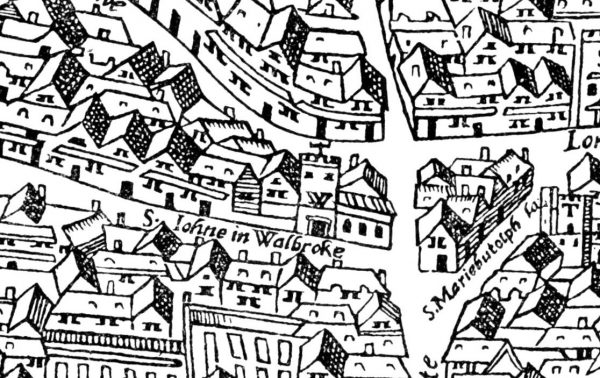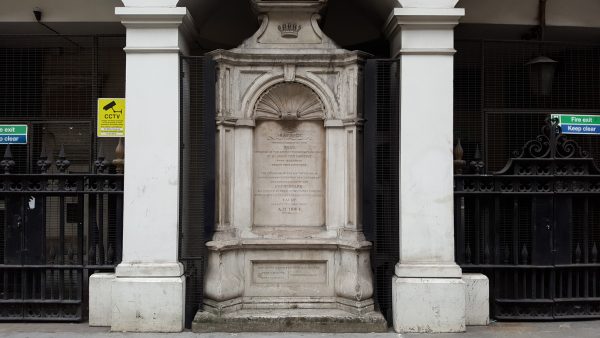A small side street near Cannon Street railway station marks the site of a ancient graveyard, and today, a ventilation shaft for the London Underground.
The ventilation shaft marks the site of the lost church of St John the Baptist upon Walbrook, which had been on the site since the 12th century, but burnt down in the Great Fire of London.
Plans to rebuild the church were never carried out, and the parish was merged with St. Antholins. The site of the church graveyard though remained intact for several hundred years until the London Underground came along.
The site was still enclosed but the greater part removed in 1884 for the extension of the District Railway. The human remains from the churchyard were collected together and put in a vault in the basement, next to the London Underground tunnels that carry the District and Circle lines.
During the excavation works, in April 1884, the navvies digging the site discovered a piece of Roman pavement, some 5 feet by 3.5 feet in size. The local press of the time said that it was removed with some difficulty and taken to the home of Sir Edward Watkin, which seems odd as the boss of the District Railway, which was digging this railway line hated him.
A building was erected above the site later, but ventilation was retained on the ground floor.
To remember those who were buried in the graveyard, and to mark their continuing slumber next to the tube trains below, there’s a memorial on the side street.
The memorial reads: “Sacred to the memory of the dead interred in the ancient church & churchyard of St John the Baptist upon Walbrook during four centuries. The formation of the District Railway having necessitated the destruction of the greater part of the churchyard all the human remains contained therein were carefully collected and reinterred in a vault beneath this monument AD 1884.”
It’s a rather charming stone memorial, even if sadly positioned beside ugly metal grills that do nothing to enhance the sanctity of the site. The City of London’s area survey notes that a number of stone memorials on the wall are “currently unsatisfactorily displayed”, which may offer hope that one day the display will be more satisfactory.
Standing next to the memorial you can read the words and feel the warm breath wafting up from the train tunnels beneath.











Who was Sir Edward Watkin and why did the boss of the District Railway hate him?
He was involved in various railway companies inc the Metropolitan Line. He was also responsible for the iron Tower built at Wembley Park which became known as Watkins Folly.
Good post, thanks Ian. Never knew this was here – I shall make a point of visiting soon.